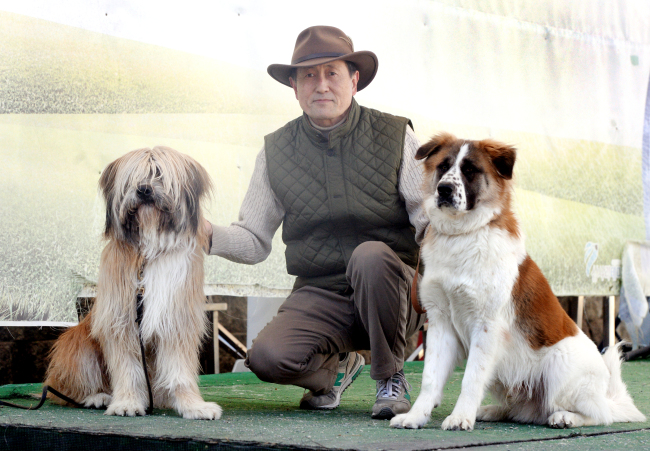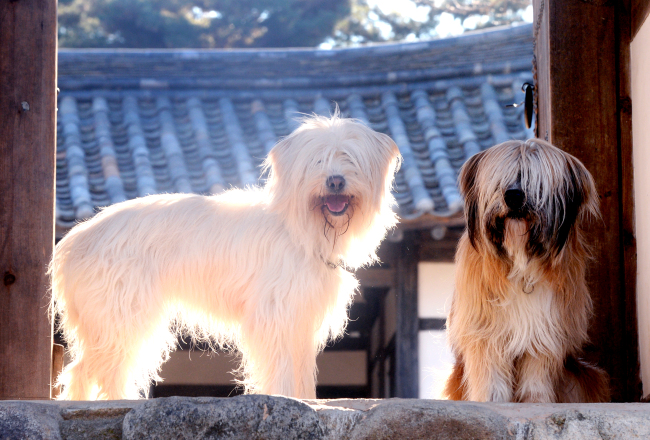Fluttering their shaggy hair against the wind, Sapsaree dogs run towards Dr. Ha Ji-hong as he steps into the pen. The once-endangered canine breed of Korean origin has made a dramatic comeback, thanks largely to decadeslong preservation efforts by Dr. Ha, also known as ”Father of Sapsaree.“
The long-haired dogs were killed en masse for their fur to make winter coats for Japanese soldiers, as documented in state archives during the period of Japanese colonial rule in Korea. In the turmoil of war and poverty that followed the colonial occupation, the traditional dog breed had nearly disappeared from its homeland.
 |
Dr. Ha Ji-hong (Center) with Sapsaree Dogs at Korea Sapsaree Foundation in Gyeongsan, North Gyeongsang Province (Park Hyun-koo/The Korea Herald) |
“When I came home in 1985 after studying Genetics in the US, I found eight Sapsarees in my father’s kennel, which he set up to preserve the breed. It struck me that these dogs might be the last remaining ones of the kind,” Ha said in an interview with The Korea Herald at his office, overlooking the hillside compound housing more than 300 Sapsarees in Gyeongsan, North Gyeongsang Province.
The geneticist started with inbreeding methods to grow the population and then applied DNA-oriented research to re-establish and stabilize the breed. As approximated by Korea Sapsaree Foundation where Ha serves as director, the breed’s population is currently 3,000. Beyond the preservation compound, Sapsarees are leading new lives as pets in local households, therapy animals and guard dogs at national heritage sites.
“Sweet-tempered Sapsarees make great companions for humans. Their strong sense of loyalty go down in history dating back to ancient Silla,” said Ha, referring to the tale about the four-legged companion saving its owner from danger. The furry creatures are portrayed alongside people of Silla Kingdom in paintings and documents from as old as seventh century.
 |
Sapsaree Dogs at Korean Folk Village attached to Yeongnam University in Gyeongsan, North Gyeongsang Province (Park Hyun-koo/The Korea Herald) |
The Sapsaree, just like the Jindo and the Donggyeongi, has been named a national treasure of Korea and governmental assistance helped further the breed’s development. However, Ha views the status of Sapsaree and other native Korean breeds to still be at a peripheral level, overshadowed by the growing popularity of more exotic dogs. “Since I started my research on native breeds in the 80s, the number of pet dogs in South Korea has grown dramatically, but the growth has been dominated by imported breeds of dogs from overseas,” he said.
While dogs of foreign origin like poodles and bulldogs remain common choice among domestic pet owners, Ha sees a potential in Sapsarees to catch the fancy of animal lovers of Korea and beyond. “The gentle temperament of Sapsaree dogs which matches their friendly appearance, makes them excellent human companions in domestic environments, as well as a more professional setting like therapy,” he said. The KSF has been running an international adoption program for overseas residents who wish to take Sapsaree dogs as pets.
“The outdated publicity surrounding dog meat consumption still overshadows the image of Korea’s dog culture in the eyes of foreigners. The uniquely Korean dog has the power to redefine the domestic pet culture dominated by foreign breeds, as well as represent our animal-friendly culture to animal lovers overseas,” said Ha.
 |
Sapsaree (Park Hyun-koo/The Korea Herald) |










